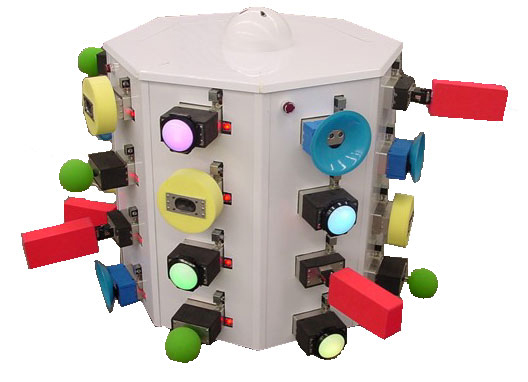Customizable robot WEAR
Machines are getting more and more sophisticated and intelligent, or “robotized,” lately. Our goal is to realize the mechanisms to foster an emotional attachment between users and machines.
Machines developed in recent years have become very complex. They are equipped with numerous functions and are therefore difficult for users to become proficient in their use. Machine intelligence is also advancing, and the machines may recognize their environment even if the users are not aware of the machines’ intelligent functions. These advances can be expressed by the statement, “All machines are becoming robots.” Considering this background, we believe that the most important function to be implemented in such complex and intelligent machines is the function to realize an emotional attachment between users and machines.
An emotional attachment would:
- Enrich human-robot interaction
- Stimulate user creativity
- Soften the user's negative reaction if machine errors occur
- Lengthen the machines' lifetime
 Concept - interaction & customize -
Concept - interaction & customize -
Products are becoming more and more customizable for users. If customization can be thought of as interaction between machines and users, then the bidirectionality of the interaction is important, as the word itself-inter-action-represents.
Conventional customizable machines receive user customization passively. They always accept a user's subjective preferences. We thought that this customization was rather simple and unidirectional. However, recent machines are becoming more intelligent and are more like robots. Do you think robots that are always passive are really intelligent? If robots have their own bodily image, they can evaluate and react to the user's customization. We hypothesize that such bidirectional interaction in which the robots would react to the customization would generate an attachment between users and robots.

The strongest reaction to the customization is “reject.” Although users might feel offended if the reaction is too strong, this reaction is necessary for users to understand that the robot is independent.
 Platform Robot - Waseda Extendable ARchitecture (WEAR)
Platform Robot - Waseda Extendable ARchitecture (WEAR)
We are developing a research platform robot called WEAR (Waseda Extendable ARchitecture). WEAR is customizable and can also evaluate and accept or refuse the user's customization.
Requirements
The requirements for our research platform robot are as follows:
- Is easily customizable
- Can recognize the customization
- Can refuse the customization
In consideration of the safety and fatigue of the users, the customization must be easy to implement even if the freedom of the customization is limited. Next, the robot must be capable of recognizing the customization in order to evaluate it. Moreover, the robot must have the function to express refusal of the user's customization.
Customization Port
We have developed “customization ports” for our research platform robot. Each customization port is rigid and robust. The port can accept customizable “modules.” A USB connection is used between the modules and the robot's PC. The modules can be ejected by a servo-motor installed behind the port. In contrast, to keep the modules, an electric latching mechanism is activated. The switch is for users to press when they want to request the robot to eject the module. Of course, the robot can ignore the request ;-)
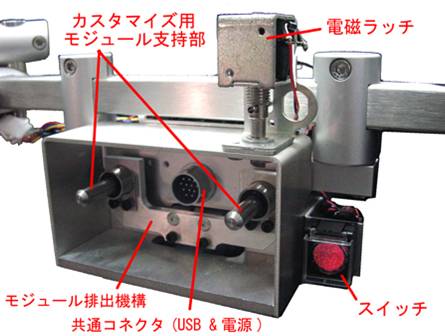
WEAR's body
The following image shows our research platform robot WEAR. We did not want the users' interactions with the robot to be defined or influenced by their first impression of it, so we intentionally designed the robot to have a plain and simple appearance that did not resemble any other creatures. WEAR's body is an octagonal prism that is 800 mm tall and 800 mm wide. It weighs approximately 76 kg. It has 32 customize ports (each side surface has 4 ports) and is an omnidirectional vehicle.
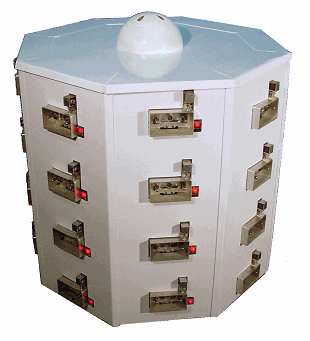
Customization Modules
The modules for customizing WEAR are shown in the following table. The modules are designed to appeal to the human senses.
| Vision | Touch | Auditory | Other | |
|---|---|---|---|---|
| Robot to Human | 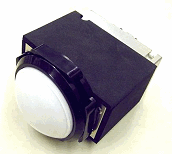 Full Color LED |
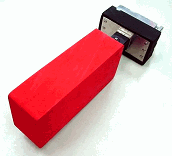 Arm |
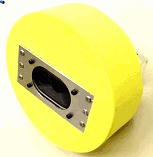 Speaker |
- |
| Human to Robot | Camera (under development) | 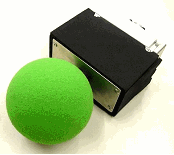 Touch Switch |
Microphone (under development) |
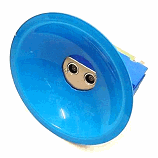 Ultra Sonic Sensor |
Example of Customization
As a result of a user's repeated customization, WEAR acquires more input/output, and its behavior becomes more complex.
